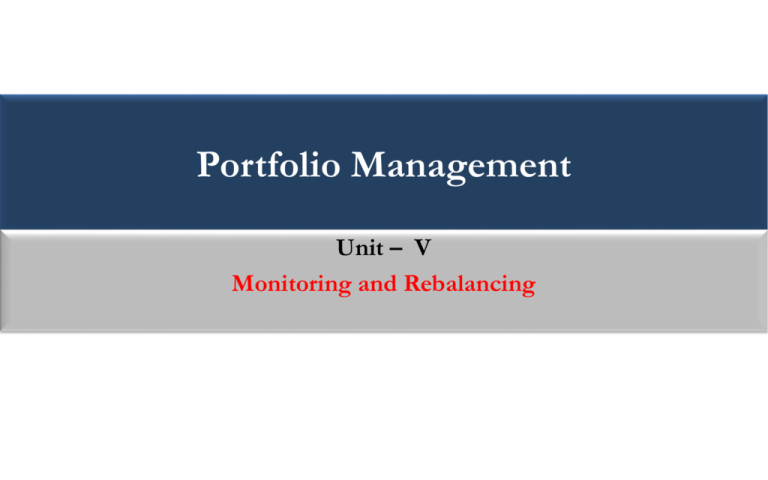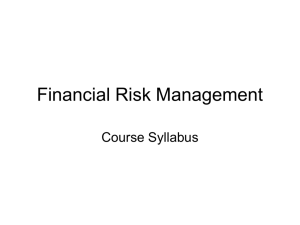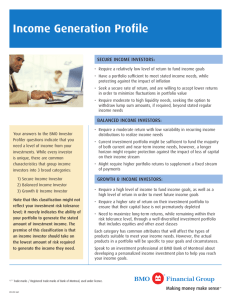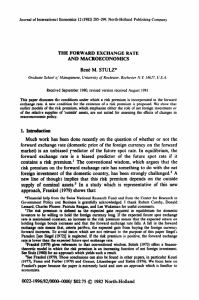PM Unit 5.1 - WordPress.com
advertisement

Portfolio Management Unit – V Monitoring and Rebalancing Unit 5 • • • • • • • • • • • • Monitoring and Rebalancing: Introduction Monitoring Changes, in Investor Monitoring Market and Economic Changes Monitoring the Portfolio, Rebalancing the Portfolio. Evaluating Portfolio Performance: Introduction Importance of Performance Evaluation Three Components of Performance Evaluation Performance Measurement Benchmarks: Concept, Properties, Types MONITORING • Monitoring the Portfolio • Monitoring a portfolio is a continuous process that requires the manager to evaluate (1) Events and trends affecting the prospects of individual holdings and asset classes and their suitability for attaining client objectives and (2) changes in asset values that create unintended divergences from the client’s strategic asset allocation. • To monitor something means to systematically keep watch over it to collect information that is relevant to one’s purpose. MONITORING • Items need for Monitoring We can categorize most items that need to be monitored in one of three ways: • 1. Investor circumstances, including wealth and constraints - Monitoring investor-related factors sometimes results in changes to a client’s investment policy statement, strategic asset allocation, or individual portfolio holdings • 2. Market and economic changes – Monitoring market and economic changes sometimes results in changes to the strategic asset allocation, tactical asset allocation adjustments, changes in style and sector exposures, or adjustments in individual holdings. • 3. The portfolio itself - Monitoring the portfolio can lead to additions or deletions to holdings or to rebalancing the strategic asset allocation MONITORING • How do you monitor the changes in Investor Circumstances and Constraints? • Changes in Investor Circumstances and Wealth • Changing Liquidity Requirements • Changing Time Horizons • Tax Circumstances • Changes in Laws and Regulations • Unique Circumstances MONITORING 1. Monitoring Changes in Investor Circumstances and Constraints: • Each client has needs and circumstances that will most likely change over time. • Changes in employment, marital status, and the birth of children may affect income, expenditures, risk exposures, and risk preferences. • Such events often mark occasions to review the client’s investment policy statement and overall financial plan. Changes in Investor Circumstances and Wealth: • Changes in wealth result from saving or spending, investment performance, and events such as gifts, donations, and inheritances.. • The investor’s return requirements may change as a result, as financial goals recede or move closer to achievement, and risk tolerance may change too. • The portfolio manager’s appraisal of a client’s risk tolerance should be largely unaffected by transient changes in wealth. MONITORING 2. Changing Liquidity Requirements: • A client needs money to spend, the portfolio manager should strive to provide it. • A liquidity requirement is a need for cash in excess of new contributions or savings as a consequence of some event, either anticipated or unanticipated. • Individual clients experience changes in liquidity requirements as a result of a variety of events, including unemployment, illness, court judgments, retirement, divorce, the death of a spouse, or the building or purchase of a home, kids education or marriage. MONITORING 3. Changing Time Horizons: • Individuals age and pension funds mature. • Reducing investment risk is generally advisable as an individual moves through the life cycle and his time horizon shortens. • Many private wealth clients have multistage time horizons. • Example: Building savings and investment and spending the same during retirement ages. • Accumulating funds for a child’s higher education can create one or more stages before retirement • Some changes in time horizon are forecastable, time horizons can also shift abruptly (Shortly) . MONITORING 4. Tax Circumstances: • Taxes are certain; the form they will take and their amount in the future are uncertain. • Taxable investors should make all decisions on an after-tax basis. • Managers for taxable investors must construct portfolios that deal with each client’s current tax situation and take future possible tax circumstances into account. • In evaluating investment strategies to meet a taxable investor’s changed objective, a portfolio manager will take into account each strategy’s tax efficiency. • For example: – Deferring the realization of income from a higher-tax year to an anticipated lower-tax year. – Accelerating expenses to a high-tax year. – Deploying assets with high unrealized gains – Realizing short-term losses at year-end to offset realized short-term gains in the same year. MONITORING 5. Changes in Laws and Regulations: • Laws and regulations create the environment in which the investor can lawfully operate, and the portfolio manager must monitor them to ensure compliance and understand how they affect the scope of the advisor’s responsibility and discretion in managing client portfolios. 6. Unique Circumstances: • A unique circumstance is an internal factor (other than a liquidity requirement, time horizon, or tax concern) that may constrain portfolio choice. • The client may present the portfolio manager with a variety of challenges in this respect. – For example :some clients direct portfolio managers to retain concentrated stock positions because of an emotional attachment to the particular holding. – a client may adopt principles of socially responsible investing – a fund may decide to reduce or eliminate holdings in ‘‘sin’’ stocks, such as gaming, alcohol, and tobacco Monitoring Market and Economic Changes Monitoring Market and Economic Changes • Factors that needed to be monitored under market and economic changes a) Changes in asset risk attributes, b) market cycles, c) central bank policy, and d) the yield curve and inflation Monitoring Market and Economic Changes a) Changes in Asset Risk Attributes: • Market prices for all assets reflect consensus perceptions of risk and reward. Changes in those perceptions produce immediate gains or losses. • Successful active managers assess differences between actual risk and perceived risk of an investment and embrace that investment when the consensus view is unduly pessimistic. b) Market Cycles: • Investors monitor market cycles and valuation levels to form a view on the short-term risks and rewards that financial markets offer. • Based on these opinions, investors may make tactical adjustments to asset allocations or adjust individual securities holdings. • Tactically, the markets’ major swings present unusual opportunities to be either very right or very wrong. • When things are going well, securities eventually perform too well; during economic weakness, stock prices often decline excessively. Monitoring Market and Economic Changes c) Central Bank Policy: • Central banks wield power in the capital markets through the influence of their monetary and interest rate decisions on liquidity and interest rates. Their influence is felt in both bond and stock markets. • In bond markets, the most immediate impact of monetary policy is on money market yields rather than long-term bond yields. A central bank’s influence on bond market volatility, however, is profound. d) The Yield Curve and Inflation • The default-risk-free yield curve reflects investors’ required return at various maturities. Yield curve changes reflect changes in bond values, and bond value changes affect equity values through the competition that bonds supply to equities. • Inflation has a pervasive influence on investors’ ability to achieve their financial and investment objectives. Inflation influences returns and risk in capital markets.







